Code Metrics – Cyclomatic Complexity
SKU: Premium, Ultimate
Versions: 2008, 2010
Code: vstipTool0131
When working with code metrics, one of the least understood items seems to be cyclomatic complexity. Essentially, with cyclomatic complexity, higher numbers are “bad” and lower numbers are “good”. We use cyclomatic complexity to get a sense of how hard any given code may be to test, maintain, or troubleshoot as well as an indication of how likely the code will be to produce errors. At a high level, we determine the value of cyclomatic complexity by counting the number of decisions made in our source code. In this tip we will start out with a simple example of cyclomatic complexity to understand the concept quickly then give some additional information on actual usage and suggested limits. Finally, I’ve added a section of citations that can be used to dig deeper into this subject.
Cyclomatic Complexity: A Simple Example
Cyclomatic complexity is defined as measuring “the amount of decision logic in a source code function” [NIST235]. Simply put the more decisions that have to be made in code, the more complex it is.
Let’s see it in action. Create a new console application and immediately calculate your code metrics by going to Analyze | Calculate Code Metrics for Solution:
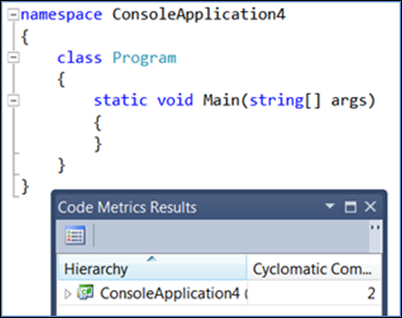
Notice the cyclomatic complexity is at 2 (the lowest value possible). If I add non-decision code, notice the complexity doesn’t change:
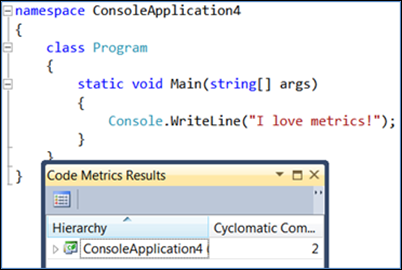
If I add a decision, the cyclomatic complexity value goes up by 1:
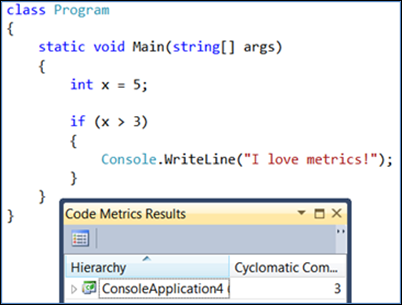
When I change the if statement to a switch statement with 4 decisions to be made then it goes from the original 2 to 6:
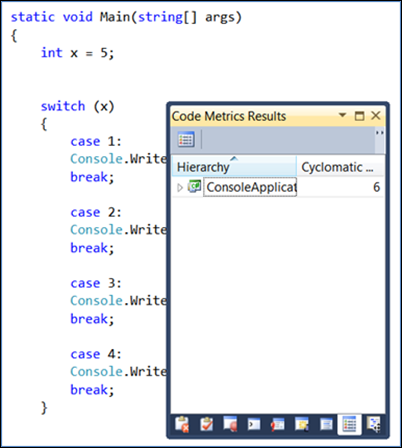
Let’s take a look at a larger code base. Here are the metrics from the Tailspin Toys sample code (https://msdn.microsoft.com/en-us/library/aa645517(VS.71).aspx):
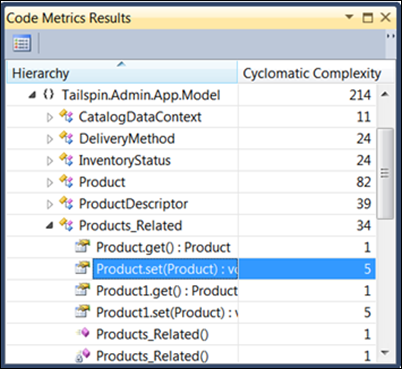
Notice that most of the items, as we drill down into the Products_Related class, have a value of 1 but a couple of them have a complexity of 5. By itself this may not be a big deal, but given that most other members have a 1 in the same class I would definitely look closer at those two items and see what is in them. You can do this by right-clicking the item and choosing Go To Source Code from the context menu. Let’s take a closer look at Product.set(Product) :
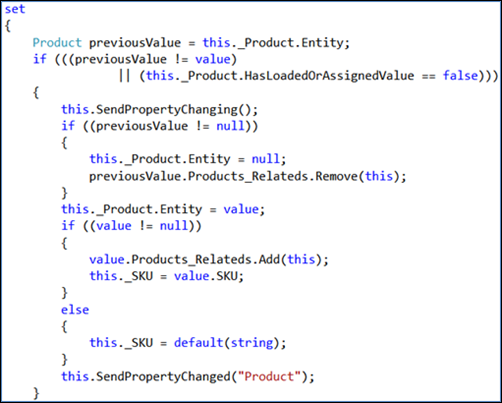
Given all the if statements, we can see why the cyclomatic complexity is at a 5. At this point we may decide that this is an acceptable level of complexity or we might refactor to reduce the complexity.
The Magic Number
As with many metrics in our industry, there is no exact cyclomatic complexity limit that fits all organizations. However, [NIST235] does indicate that a limit of 10 is a good starting point:
“The precise number to use as a limit, however, remains somewhat controversial. The original limit of 10 as proposed by McCabe has significant supporting evidence, but limits as high as 15 have been used successfully as well. Limits over 10 should be reserved for projects that have several operational advantages over typical projects, for example experienced staff, formal design, a modern programming language, structured programming, code walkthroughs, and a comprehensive test plan. In other words, an organization can pick a complexity limit greater than 10, but only if it is sure it knows what it is doing and is willing to devote the additional testing effort required by more complex modules.” [NIST235]
Cyclomatic Complexity and Line Numbers
As I mentioned in vstipTool130 (“Code Metrics – Lines of Code”), just looking at the number of lines of code by itself is, at best, a very broad predictor of code quality. There is some basic truth to the idea that the more lines of code in a function, the more likely it is to have errors. However, when we combine cyclomatic complexity with lines of code then we have a much clearer picture of the potential for errors.
As described by the Software Assurance Technology Center (SATC) at NASA:
“The SATC has found the most effective evaluation is a combination of size and [Cyclomatic] complexity. The modules with both a high complexity and a large size tend to have the lowest reliability. Modules with low size and high complexity are also a reliability risk because they tend to be very terse code, which is difficult to change or modify.” [SATC]
Code Analysis
When using code analysis, the Design Guideline rule sets contain maintainability areas:
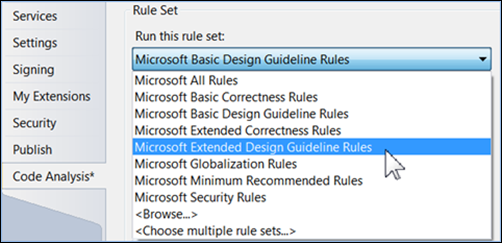
Inside the maintainability area is a rule for complexity:

This rule issues a warning when the cyclomatic complexity reaches 25 so it is a good thing to have to keep you from having excessive complexity. You can learn more about the rule here: https://msdn.microsoft.com/en-us/library/ms182212.aspx
Special Note on Visual Studio 2010
There may be differences when calculating code metrics using Visual Studio 2010 that don’t apply to Visual Studio 2008. The online documentation (https://msdn.microsoft.com/en-us/library/ee703787.aspx) gives the following reasons:
- The function contains one or more catch blocks. In previous versions of Visual Studio, catch blocks were not included in the calculation. In Visual Studio 2010, the complexity of each catch block is added to the complexity of the function.
- The function contains a switch (Select Case in VB) statement. Compiler differences between Visual Studio 2010 and earlier versions can generate different MSIL code for some switch statements that contain fall-through cases.
Putting It All Together
The bottom line is that a high complexity number means greater probability of errors with increased time to maintain and troubleshoot. Take a closer look at any functions that have a high complexity and decide if they should be refactored to make them less complex.
Citations
[MCCABE5]
McCabe, T. and A. Watson (1994), Software Complexity (CrossTalk: The Journal of Defense Software Engineering).
[NIST235]
Watson, A. H., & McCabe, T. J. (1996). Structured Testing: A Testing Methodology Using the Cyclomatic Complexity Metric (NIST Special Publication 500-235). Retrieved May 14, 2011, from McCabe Software web site: https://www.mccabe.com/pdf/mccabe-nist235r.pdf
[SATC]
Rosenberg, L., Hammer, T., Shaw, J. (1998). Software Metrics and Reliability (Proceedings of IEEE International Symposium on Software Reliability Engineering). Retrieved May 14, 2011, from Penn State University web site: https://citeseerx.ist.psu.edu/viewdoc/download?doi=10.1.1.104.4041&rep=rep1&type=pdf
Comments
Anonymous
December 25, 2013
Very helpful article to explain the CC.Anonymous
February 09, 2014
Helpful.. Can you give a rough outline on how to implement the cylomatic complexity?Anonymous
February 09, 2014
The comment has been removedAnonymous
February 10, 2014
Right. In case I want to build my own metric to calculate the same in visual studio, how should i proceed!?Anonymous
February 10, 2014
Can you pls tell me the logic behind how to calculate cyclomatic complexity ?Anonymous
February 13, 2014
Here is the actual way to do calculations: en.wikipedia.org/.../Cyclomatic_complexity Slightly easier to understand logic can be found here: www.ehow.com/how_7870069_calculate-cyclomatic-complexity.html The values may not match exactly between the two methods but they are close enough. ZAnonymous
March 12, 2014
hey can you please tell me alternatives of to calculate the code complexity factor..?? like c&k ...Anonymous
March 12, 2014
Hello Amit :) I show how to do cyclomatic complexity above so not sure if you are asking for that or an overall number. I'm not a big fan of one number to represent the overall health of the code simply because I think it obscures essential pointers to clues for fixing the code. I would suggest you focus on the metrics that mean the most to your organization and use them. Of course, you should never, EVER use "lines of code" as a metric for anything other than showing you how many lines of code you have written. It is a completely useless metric otherwise. ZAnonymous
September 23, 2014
I am using visual studio2005 version. Can you guide me how can go ahead cyclomatic complexity? Are there any seperate tool do we need to use? if yes can you guide me.Anonymous
December 04, 2014
The cyclomatic complexity for a solution shows up as 776. However note that, this number is made up of CC"s from individual projects contained within the solution whose CC's range from 1 to 300. Should I be considering the CC of the project or the CC of the most granular node within a class ? In the below example the most granular node is Method M. Project A -> CC of 500 Class C within Project A -> CC of 100 Method M in Class C -> CC of 12Anonymous
June 04, 2015
Does the CCN gets applied to any functional configurations done?Anonymous
June 17, 2015
Why do you say that 2 is the lowest value possible for the cyclomatic complexity? According to the cyclomatic complexity formula, the lowest value possible would be 1, right?Anonymous
October 05, 2015
How I can take a value of cyclomatic complexity of a project? How I can evaluate a project or package? My project has a value of 7901 in CC, this value does not help me to contrast with McCabe.